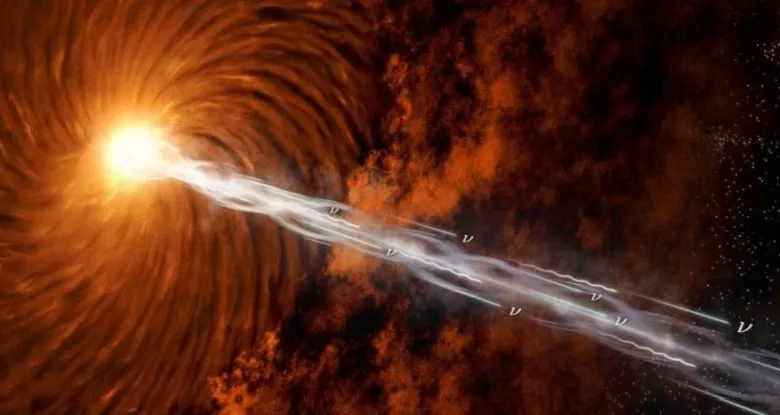New study has verified that the mysterious source of high-energy cosmic neutrinos is some of the brightest and most energetic objects in the Universe.
A thorough examination has rather clearly linked these mysterious particles to galaxies that contain blazars, or blazing nuclei.
It’s a finding that offers an incredibly surprising solution to a conundrum that astrophysicists have been puzzling over for years.
- An excerpt from Andersen’s autobiography, what he felt when he lost his father
- Frankfurt Airport gears up for toughest weekend ever
According to astronomer Sara Buson of the Julius Maximilian University of Würzburg in Germany, “the data give, for the first time, unmistakable observational proof that the sub-sample of PeVatron blazars are extragalactic neutrino sources and consequently cosmic ray accelerators.”
Even under the best circumstances, neutrinos are odd little objects. These subatomic particles are among the most prevalent and pervasive in the universe.
Though they are electrically neutral, practically massless, and barely interact with anything else in the universe. Neutrinos are referred to as ghost particles because to them, the ordinary stuff that makes up the majority of the universe could as well be a shadow.
We are fairly certain about the origin of ordinary neutrinos.
They are created by radioactive decay, which happens quite often. The majority of neutrinos that we observe on Earth are by-products of nuclear processes in the Sun, but they can also be created by other sources, such as supernovae, artificial nuclear reactions, cosmic ray interactions with atoms, or artificial nuclear reactions.
But several extremely odd ones were discovered by a specialized observatory in Antarctica.

Neutrinos rarely interact with ordinary stuff, yet they occasionally do. They can cause a very little flash of light when they come into contact with water molecules.
Deep in the Antarctic ice at the south pole, the IceCube Neutrino Observatory has detectors that can pick up these flashes. The energy of the neutrino can be determined by these detections.
Two neutrinos that IceCube discovered in 2012 were unlike anything we had ever seen. They were 100 million times more energetic than supernova neutrinos, with energy measured in petaelectronvolts (PeV). And the source of these high-energy neutrinos, which was unknown, was in intergalactic space.
In 2018, we learned something about that source. Neutrinos don’t interact, thus they essentially move in a straight line through space. This property allowed a massive worldwide team of scientists to track a high-energy neutrino back to a blazar.
That is the core of a huge galaxy, driven by an active supermassive black hole, and it is positioned in such a way that jets of ionized matter traveling at close to the speed of light directly address Earth.
Francis Halzen, a physicist at the University of Wisconsin-Madison, commented at the time, “It is intriguing that there was a general opinion in the astrophysics community that blazars were unlikely to be generators of cosmic rays, and here we are.
There are still some unanswered questions regarding the connection between blazars and high-energy neutrinos. So, a group of scientists under the direction of Buson went digging like scientists do.
They meticulously analyzed 7 years’ worth of all-sky neutrino data from IceCube to a list of 3,561 objects that are either verified blazars or very probable to be blazars.
They tried to see if high-energy neutrinos could be definitively linked to the locations of blazars in the sky by doing positional cross-matching of these catalogs.
According to astrophysicist Andrea Tramacere of the University of Geneva in Switzerland, “using this data, we had to verify that the blazars whose directional locations agreed with those of the neutrinos were not there by mistake.”
“We found that the random association can only outperform the genuine data once every million trials after rolling the dice numerous times. This provides solid support for the validity of our relationships.”
The team’s analysis shows that the likelihood of a chance event is 0.0000006. This shows that at least some blazars can generate high-energy neutrinos, which in turn aids in the solution of a different issue. Another great enigma is the source of high-energy cosmic rays, which are protons and atomic nuclei that travel through space at speeds that are almost as fast as light.
According to Buson, only processes that include the acceleration of cosmic rays can yield high-energy neutrinos. The team concluded that we may now indirectly relate blazars to cosmic ray acceleration.
The creation of relativistic jets, where accelerated particles emit radiation with energy up to a billion times that of visible light, is caused by the accretion process and rotation of the black hole. said Tramacere.
The “Rosetta stone” of high-energy astrophysics may have been found when the relationship between these items and cosmic rays was discovered.
There are a number of directions that merit additional investigation from here. One is to investigate why some blazars function as effective particle accelerators while others do not. This will aid the researchers in identifying neutrino factories’ properties and potential locations in the universe.
The origins of these strange, ghostly particles may also be discovered by additional, more in-depth investigations of neutrino data.
The Astrophysical Journal Letters is where the study was published.

